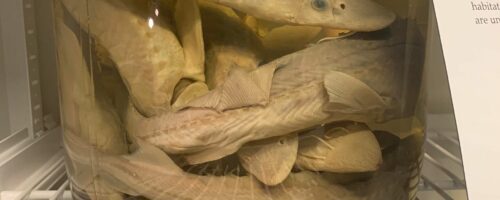
Beaty Biodiversity Museum, Vancouver Campus, Main Mall, Vancouver, BC, Canada
Our visit to the Beaty Biodiversity Museum on Monday, July 11th was an impactful reminder of when we began developing our inquiry question as part of our land-based inquiry adventure as a group. We focused on the Sturgeon Harpoon Knowledge Web as a catalyst to reconnect with our initial focus, which was on interconnectedness. Keira focused on the elk antlers and their role in the harpoon. She pointed out secelenexW Morgan Guerin’s quote about hanging the bone in the rafters above the fire so the smoke can get into the pores and make it stronger, thus making it more useful than slate, wondering aloud “how long did it take to figure that out?” and “what else did they use elk antlers for?” This started a side conversation about possibilities such as weapons and cooking tools. Vanessa highlighted the artistic beauty of the harpoon itself , noting that the tool is a work of art in itself, as well as being a practical tool to provide food for the Musqueum Nation. Jenn drew the group’s attention to the poster with the web displayed from the harpoon. As an advocate for diverse learners, she felt this piece would be helpful for more visual learners to understand the connectedness of the contributors to the sturgeon harpoon. Allison located the sturgeons on display in formaldehyde in the museum, striking a discussion on the sheer size and origin of sturgeons. Our group learned that fossils of sturgeon have shown that they are descended from fish in the Jurassic period and that they can live for 50-60 years. Some sturgeon continue to be harvested for their roe which is a delicacy (caviar) and are now considered critically endangered. This led to a discussion about species vulnerability. Emma found the poster explaining that the shaft of the harpoon was often made by wood from the Douglas Fir and reminded us about our cohort’s visit to the UBC Botanical Gardens where we walked the tree walk that was mainly based around Douglas and Grand fir trees and their importance of so many aspects of history. Lastly, as the bell was rung, the group stopped briefly in the area where the Sturgeon Harpoon poster QR code took visitors to the gallery. Sheana followed the link and the group enjoyed seeing the various lifelike sturgeon swimming. A final discussion about interconnectedness, vulnerability and the importance of us being mindful of our roles as Stewards led to us coming to realize that by continuing to learn, reflect and have the opportunity to connect to land, we become allies with the land.

